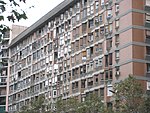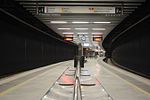Navas (Barcelona Metro)
Barcelona Metro line 1 stationsBarcelona Metro stubsRailway stations located underground in SpainRailway stations opened in 1953Spanish railway station stubs ... and 1 more
Transport in Sant Andreu

Navas is a Barcelona Metro station located in the Sant Andreu district of Barcelona, served by L1. It opened in 1953. The name refers to carrer Navas de Tolosa, and the station was originally called Navas de Tolosa until it adopted its current name in 1982. Like the rest of stations in this section of L1, Navas is located under Avinguda Meridiana, and can be accessed from the street of the same name and from carrer de Biscaia. On 21 February 2007 a deaf ONCE lottery seller was murdered in the station by being pushed on to the railtrack.
Excerpt from the Wikipedia article Navas (Barcelona Metro) (License: CC BY-SA 3.0, Authors, Images).Navas (Barcelona Metro)
Avinguda Meridiana, Barcelona
Geographical coordinates (GPS) Address Nearby Places Show on map
Geographical coordinates (GPS)
| Latitude | Longitude |
|---|---|
| N 41.415555555556 ° | E 2.1869444444444 ° |
Address
Avinguda Meridiana
Avinguda Meridiana
08001 Barcelona (Sant Andreu)
Catalonia, Spain
Open on Google Maps










